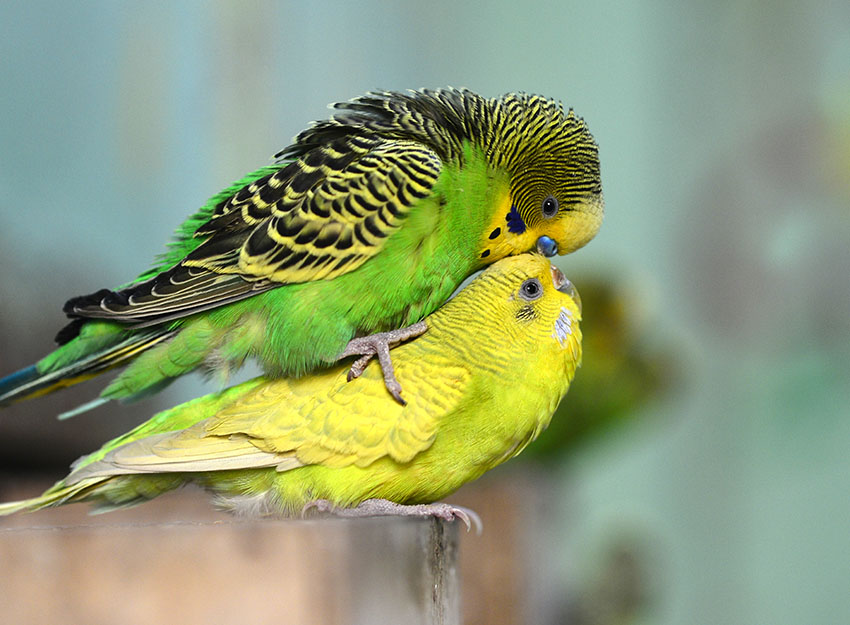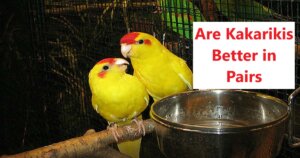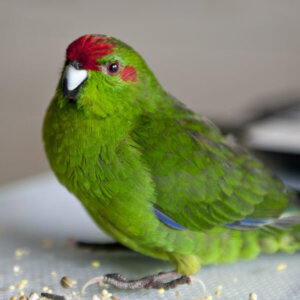Do Kakarikis Mate For Life?: Unveiling Their Bonding Secrets
No, Kakarikis do not mate for life. They can form strong bonds, but they are not monogamous.
Kakarikis, also known as New Zealand parakeets, are charming and lively birds. They captivate bird enthusiasts with their playful nature and colorful plumage. Understanding their mating behavior is crucial for anyone considering these birds as pets. While they form bonds, their social structure is more complex.
Unlike some bird species that mate for life, Kakarikis often change partners. This behavior ensures genetic diversity and stronger offspring. If you are keen to learn more about the fascinating world of Kakarikis and their unique mating habits, read on. This article will explore their behaviors and what it means for Kakariki owners.

Credit: www.omlet.us
Introduction To Kakarikis
Kakarikis are small, charming parrots native to New Zealand. These birds are known for their vibrant colors and playful nature. They make engaging and entertaining pets. But do these lively birds mate for life? Before diving into their mating habits, let’s first understand their origin and habitat, and physical characteristics.
Origin And Habitat
Kakarikis, also known as New Zealand parakeets, come from New Zealand. They thrive in various habitats, including forests, scrublands, and coastal regions. These birds are adaptable and can live in different environments. They prefer areas with dense vegetation, which provides food and shelter. Their natural habitat is rich in fruits, seeds, and insects.
Physical Characteristics
Kakarikis are small to medium-sized parrots. They measure around 10 to 11 inches in length. They have a vibrant green plumage with red markings on their heads. Some species have yellow patches on their bodies. Their long tails and strong beaks help them forage for food. Kakarikis are agile and quick, making them excellent flyers. Their playful nature and bright colors make them popular pets.
Social Behavior Of Kakarikis
Kakarikis are vibrant, playful parrots known for their lively social behavior. Understanding their social dynamics helps in providing better care and fostering a healthy environment for them. Their interactions within their flock and their unique ways of communication are fascinating aspects of their social behavior.
Interaction With Flock
Kakarikis are highly social birds. They thrive in the company of their flock. Whether in the wild or in captivity, they engage in frequent social interactions. These birds are rarely seen alone. They form strong bonds with their flock members.
| Behavior | Description |
|---|---|
| Preening | They groom each other to strengthen bonds. |
| Playing | They engage in playful activities together. |
| Feeding | They often feed together, sharing food. |
Within the flock, Kakarikis establish a social hierarchy. Dominant birds often lead the group. Subordinate birds follow and learn from them. This hierarchy helps maintain order and reduces conflicts.
Communication Methods
Communication is key in Kakariki’s social life. They use various methods to convey messages and emotions. Vocalizations are their primary means of communication. They produce a range of sounds, from chirps to loud calls.
- Chirping: Indicates contentment and social interaction.
- Screeching: Signals alarm or distress.
- Whistling: Used during courtship and bonding.
Body language also plays a significant role. Kakarikis use their body postures to express feelings. For example, a raised crest shows excitement or curiosity. On the other hand, a flattened crest may indicate fear or submission.
In addition to vocal and physical cues, they use tactile communication. Preening and nuzzling are common gestures that strengthen their bonds. These actions are essential for maintaining harmony within the flock.
Bonding Patterns
Kakarikis, or New Zealand parakeets, have unique bonding patterns. Their social nature influences these patterns. Understanding these helps in keeping them healthy and happy.
Pair Formation
Kakarikis often form pairs in captivity and the wild. These pairs are usually male and female. The formation begins with the male showing interest. He may follow the female and try to get her attention. If she is interested, they start spending more time together. This period is crucial for their bonding.
Bonding Rituals
Once a pair forms, they engage in bonding rituals. These include mutual preening. Preening helps them build trust. They clean each other’s feathers, which strengthens their bond. Feeding each other is another ritual. The male often feeds the female. This act shows care and commitment. Vocalizations are also part of bonding. They communicate through soft calls and chirps. These sounds reassure each other of their presence.
Mating Habits
Kakarikis, known for their vibrant colors and playful nature, have unique mating habits. Understanding their behavior helps in providing a suitable environment for them.
Courtship Behavior
Kakarikis engage in elaborate courtship displays. The male performs various actions to attract the female. He may sing, dance, or offer food. These displays show his health and suitability as a mate.
The male often fluffs his feathers and spreads his tail. He may also perform a series of hops and flights around the female. This behavior is crucial for establishing a bond.
During this period, the female observes and decides if the male is a suitable partner. If she accepts, they will engage in mutual preening, which strengthens their bond.
Nesting Preferences
Kakarikis are particular about their nesting sites. They prefer to nest in tree cavities or nest boxes. These locations provide safety and comfort for their eggs.
They line their nests with soft materials. This includes leaves, feathers, and small twigs. The female does most of the nesting work, ensuring the nest is secure and comfortable.
Once the nest is ready, the female lays her eggs. The incubation period lasts around 21 days. During this time, the male may help by providing food for the female.
Mate Selection
Do Kakarikis mate for life? This question often intrigues bird lovers. Understanding their mate selection helps unravel this mystery. Kakarikis are unique in how they choose their partners. Their selection process is fascinating and complex.
Criteria For Choosing Partners
Kakarikis consider several factors when choosing their mates. Health is a primary criterion. They prefer strong, healthy partners. Vibrant feathers and active behavior signal good health. Age also plays a role. Mature birds are often more attractive. Experience in the wild adds to their appeal.
Role Of Compatibility
Compatibility is crucial in Kakariki mate selection. Birds with similar temperaments get along better. They communicate more effectively. Harmony in behavior fosters a strong bond. This compatibility boosts their chances of mating for life.

Credit: www.facebook.com
Lifelong Partnerships
Kakarikis are known to form lifelong partnerships. These colorful parakeets often stay with their chosen mate for life, creating strong bonds.
Kakarikis are small, colorful parrots native to New Zealand. They are known for their vibrant plumage and playful nature. But do these charming birds form lifelong partnerships? Many bird enthusiasts believe that Kakarikis exhibit strong monogamous behavior, forming deep bonds with their mates.Signs Of Monogamy
Kakarikis often show signs of monogamy through their behavior. They spend a lot of time together. They preen each other’s feathers, a sign of affection and bonding. During feeding times, they often share food with their mate. This mutual care strengthens their bond. Their loyalty to one another is evident in their interactions.Factors Influencing Lifelong Bonds
Several factors influence the formation of lifelong bonds in Kakarikis. Environment plays a crucial role. A stable and safe habitat encourages bonding. Availability of resources like food and nesting sites also matters. Stress-free environments help them form and maintain bonds. The presence of other Kakarikis can affect their relationship dynamics. Social interactions with the flock impact their pair bonding. Understanding these factors helps in creating a conducive environment for Kakarikis. It supports their natural behavior and promotes lifelong partnerships. “`Challenges To Bonding
Understanding the challenges to bonding in Kakarikis is crucial for their well-being. Bonding is essential for their emotional health and mating success. However, several factors can impact their ability to form and maintain strong bonds.
Environmental Stressors
Environmental stressors can disrupt the bonding process in Kakarikis. These birds thrive in a stable and comfortable environment. Any changes, such as moving cages or loud noises, can cause stress. Stress can lead to aggression or withdrawal, making bonding difficult.
Temperature fluctuations and improper lighting can also affect their mood. Kakarikis need a consistent temperature and a natural light cycle. This helps them maintain a healthy routine and reduces stress. Ensuring a calm and stable environment can help Kakarikis bond better.
Human Interference
Human interference can also impact Kakariki bonding. Handling these birds too frequently can cause anxiety. They need space to interact with each other naturally. Overhandling can make them dependent on humans, disrupting their natural bonding process.
Additionally, improper socialization can be a problem. Introducing new birds without proper acclimatization can lead to fights. Kakarikis need time to get used to each other. Gradual introductions and monitored interactions can help them bond.
| Challenge | Impact on Bonding |
|---|---|
| Environmental Stressors | Causes stress, aggression, and withdrawal |
| Human Interference | Leads to anxiety and disrupted natural bonding |
Creating a stable environment and minimizing interference are key. This helps Kakarikis form and maintain strong bonds.

Credit: www.birdcagesnow.com
Enhancing Kakariki Bonds
Creating a strong bond between Kakarikis can be a rewarding experience. These beautiful parrots thrive when they feel secure and loved. Understanding their needs is key to nurturing a lasting relationship.
Creating A Supportive Environment
Provide a spacious cage with plenty of room for movement. Ensure the cage has various perches at different heights. This mimics a natural setting and keeps them active.
Include toys and foraging opportunities. These stimulate their minds and encourage natural behaviors. Regularly clean the cage to maintain hygiene.
Encouraging Natural Behavior
Observe your Kakarikis and allow them to interact freely. This strengthens their bond and helps them feel secure.
Offer a varied diet with fresh fruits, vegetables, and seeds. A balanced diet supports their overall health and well-being.
Spend time with your birds each day. This builds trust and familiarity. Hand-feeding treats can also enhance their bond with you.
Frequently Asked Questions
Do Kakarikis Form Lifelong Bonds?
Kakarikis do not typically form lifelong bonds. They are known for being social and may form temporary pairings. These bonds can change over time.
How Do Kakarikis Choose Mates?
Kakarikis choose mates based on compatibility and social interactions. They often engage in mutual preening and vocalizations to strengthen their bond.
Can Kakarikis Mate With Different Partners?
Yes, Kakarikis can mate with different partners. They are not strictly monogamous and may switch partners throughout their lives.
What Is The Mating Behavior Of Kakarikis?
Kakarikis exhibit courtship behaviors like mutual preening and feeding. These behaviors help establish and strengthen their bond with potential mates.
Conclusion
Kakarikis are fascinating birds with unique social behaviors. They do not mate for life, but form strong bonds. These bonds can change over time. Understanding their behavior helps in providing better care. Kakarikis thrive in environments that respect their social needs.
Observing their interactions can be rewarding. It’s essential to create a supportive habitat. This ensures happy and healthy Kakarikis. Their lively nature brings joy to bird enthusiasts. Regular attention and proper care are key. Enjoy the vibrant company of your Kakarikis!
Hello Dear, I'm Poli Kolymnia, owner of many birds (including budgies).
With a deep passion for these feathered companions, I'm here to share my expertise and extensive knowledge on birds care.
My articles cover essential topics like diet, housing, care, and health, providing practical tips to help you create a happy and thriving environment for your birds.





